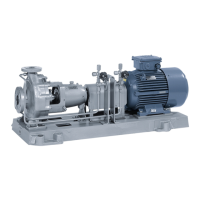6 Commissioning/Start-up/Shutdown
47 of 80
HPK
1121.8/06-EN
Table19: Frequency of starts
Motor rating Maximum frequency of starts
[kW] [Starts/hour]
≤ 12 15
≤ 100 10
> 100 5
CAUTION
Re-starting while motor is still running down
Damage to the pump (set)!
▷ Do not re-start the pump set before the pump rotor has come to a standstill.
6.2.3 Fluid handled
6.2.3.1 Flow rate
Unless specified otherwise in the characteristic curves or in the data sheets, the
following applies:
▪ Short-time operation: Q
min
7)
=0.1×Q
BEP
8)
▪ Continuous operation: Q
min
7)
=0.3×Q
BEP
8)
▪ 2-pole operation: Q
max
9)
=1.1×Q
BEP
8)
▪ 4-pole operation: Q
max
9)
=1.25×Q
BEP
8)
The data refer to water and water-like fluids. Longer operating periods with these
fluids and at the flow rates indicated will not cause an additional increase in the
temperatures on the pump surface. However, if the physical properties of the fluids
handled differ from those of water, the calculation formula below must be used to
check if an additional heat build-up may lead to a dangerous temperature increase at
the pump surface. If necessary, the minimum flow must be increased.
Table20: Key
Symbol Description Unit
c Specific heat capacity J/kg K
g Acceleration due to gravity m/s²
H Pump discharge head m
T
f
Fluid temperature °C
T
O
Temperature at the casing surface °C
Pump efficiency at duty point -
Temperature difference K
6.2.3.2 Density of the fluid handled
The power input of the pump set will change in proportion to the density of the fluid
handled.
7
Minimum flow rate
8
Flow rate at best efficiency point
9
Maximum flow rate

